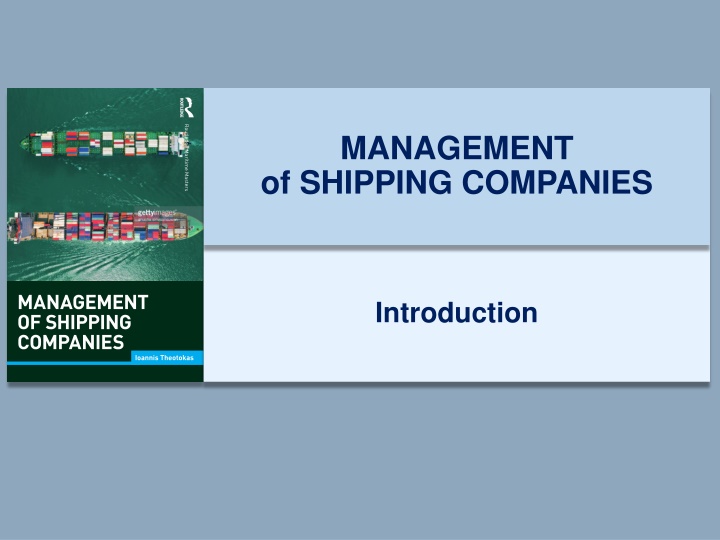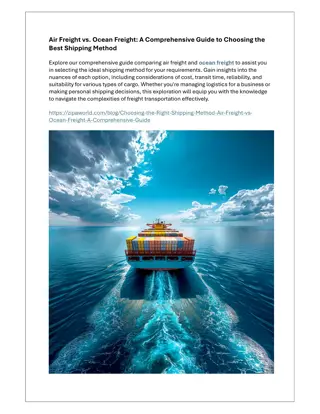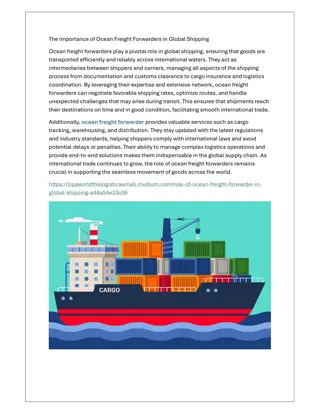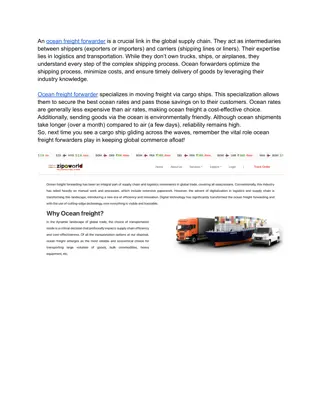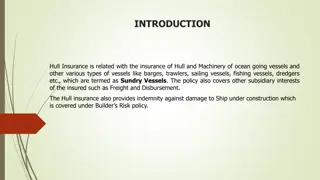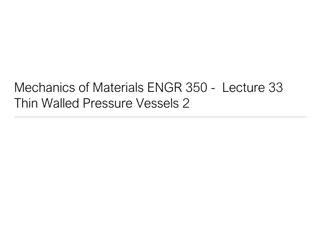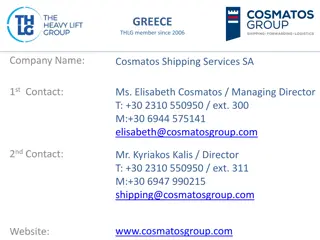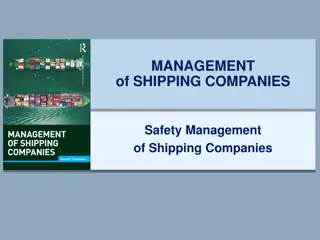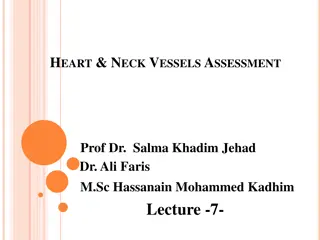Overview of Shipping Company Management and Vessels in the Shipping Industry
This content provides an insightful overview of the management of shipping companies, including the analysis of Greek-owned shipping companies and the role of the business environment. It also discusses the basic distinctions in the shipping industry, types of vessels in bulk shipping, tankers, specialized vessels, and general cargo vessels.
Download Presentation

Please find below an Image/Link to download the presentation.
The content on the website is provided AS IS for your information and personal use only. It may not be sold, licensed, or shared on other websites without obtaining consent from the author.If you encounter any issues during the download, it is possible that the publisher has removed the file from their server.
You are allowed to download the files provided on this website for personal or commercial use, subject to the condition that they are used lawfully. All files are the property of their respective owners.
The content on the website is provided AS IS for your information and personal use only. It may not be sold, licensed, or shared on other websites without obtaining consent from the author.
E N D
Presentation Transcript
MANAGEMENT of SHIPPING COMPANIES Introduction
Aim of the course To analyse the organisation and management of shipping companies To discuss the role of the business environment of shipping in the organisation and management of shipping companies To analyse the characteristics of Greek-owned shipping companies Introduction I. Theotokas (2018) Management of Shipping Companies London: Routledge 2
Basic distinctions in the shipping industry Bulk shipping Liner shipping Specialised shipping Passenger shipping Introduction I. Theotokas (2018) Management of Shipping Companies London: Routledge 3
Ships of bulk shipping bulk carriers Mini bulkers, below 10,000 dwt; Handysize, 18,000 - 30, 000 dwt Handymax, 30,000 - 50,000 dwt; Supramax, 50,000 - 60,000 dwt; Panamax, 60,000 - 80,000 dwt; Capesize, of even more than 200,000 dwt; VLOC (very large ore cariers), of 4000,000 dwt Introduction I. Theotokas (2018) Management of Shipping Companies London: Routledge 4
Ships of bulk shipping - tankers Small tankers, of up to 10.000 dwt; Handysize & handymax, of 18.000 50.000 dwt; Panamax, of 50.000-70.000 dwt Aframax, of 70.000 120.000 dwt; Suexmax, of 120.000-200.000 dwt; VLCC, of 200.000 300.000 dwt ULCC, may exceed 560.000 dwt Product tankers Chemical tankers Introduction I. Theotokas (2018) Management of Shipping Companies London: Routledge 5
Specialised vessels Vehicle carriers Chip carriers Cement carriers Liquid Petroleum Gas (LPG) and Liquid Natural Gas (LNG) tankers Refrigerated ships Heavy lift vessels Introduction I. Theotokas (2018) Management of Shipping Companies London: Routledge 6
General cargo vessels Tweendeckers: Classic general cargo or bulk cargo vessels, of a carrying capacity of 18,000 dwt, Containerships: The largest vessels in this category have a carrying capacity that exceeds 20.000 teu Roll on - Roll off (Ro-Ro): Ships on to which it is possible to load vehicles bearing a load, as they have a ramp instead of lifting machinery. Multi-purpose carriers: Vessels with double decks, holds with a large opening, and heavy lifting machinery Barge-carrying vessels: Vessels which carry barges bearing a cargo, as they have special loading and discharging systems which permit them to handle them like containers. Introduction I. Theotokas (2018) Management of Shipping Companies London: Routledge 7
The shipping company (I) The economic unit which uses the factors of production for the production and provision of maritime transportation services A company, an individual or a small group of individuals who take decisions on the employment (and/or otherwise) of the factors of production in the shipping world (Metaxas, 1988 The individuals who take the decisions (shipping entrepreneurs) for the markets / sectors which they will engage in the types of vessels required for this the timing for the investment the nature of the financing to be chosen the capital which will be drawn upon the insurance cover of the vessel the operational management required Introduction I. Theotokas (2018) Management of Shipping Companies London: Routledge 8
The shipping company (II) The shipping company is an organisation consisting of two basic parts: The productive units/ the vessels The infrastructure on land/the office The need for coordination Introduction I. Theotokas (2018) Management of Shipping Companies London: Routledge 9
The shipping company and the chartering of ships in bulk cargo shipping VESSELS CARGOES CHARTERING INTENSITY? OF? COMPETITION SHIPPERS/ CHARTERERS SHIPPING? COMPANIES Introduction I. Theotokas (2018) Management of Shipping Companies London: Routledge 10
Categories of shipping companies (Ownership/degree of integration of activities) Subsidiaries of major industrial or merchandising groups Companies integrated with ship-building, ship brokering, forwarding etc. or vertically integrated companies Pure transporting companies exclusively concerned with shipping Diversified companies in shipping and non- shipping sectors Horizontally integrated Vertically integrated Diversified Introduction I. Theotokas (2018) Management of Shipping Companies London: Routledge 11
Organisation and management of shipping companies (I) Organisation and management of shipping companies requires knowledge of the structure and of the specific traits of shipping industry and of its markets The analysis and interpretation of the organisation, manner of administration and strategies of shipping companies presuppose an understanding of the framework within which they operate Introduction I. Theotokas (2018) Management of Shipping Companies London: Routledge 12
Organisation and Management: Approaches and theories Classical theory a combination of theories which focuses on productivity and the effectiveness of individuals and organisations Behavioral theory approaches organisations as phycho-social phenomena and focuses on their behavioral dimension Systems theory approaches organisations as systems consisting of interconnecting parts which have a common aim. Contingency theory recognises that organisations differ and examines the factors which contribute to this Introduction I. Theotokas (2018) Management of Shipping Companies London: Routledge 13
Systems approach ORGANISATION OUTPUT INPUT Transformation Feedback Introduction I. Theotokas (2018) Management of Shipping Companies London: Routledge 14
Contingency approach There are no optimum solutions. Managers seek find different solutions for problems in different situations/contexts The external environment sets limits to managers. It is unique for every single company The internal subsystems of the company are unique External and internal environment provide the basis for the organization and management of every company Introduction I. Theotokas (2018) Management of Shipping Companies London: Routledge 15
Organisation and management of shipping companies (II) The complexity of organizational and managerial phenomena asks for the adoption of flexible and adaptive approaches that are not confined by dogmas or by rules that apply to every situation Every shipping company is affected by the conditions of the sectors it operates Optimum solutions apply only in specific situations and cannot be used as rules Introduction I. Theotokas (2018) Management of Shipping Companies London: Routledge 16
Organisation and management of shipping companies (III) There are no right and wrong theories in management Each theory explains and at the same time obscures (Morgan, 2000) The basic characteristics of shipping companies reinforce the analytical force of these approaches for the study of their organisational and managerial phenomena. These approaches manifest significant weaknesses. The employment of the advantages of the various theories and approaches for the analysis of shipping companies as organisations is sought Introduction I. Theotokas (2018) Management of Shipping Companies London: Routledge 17
